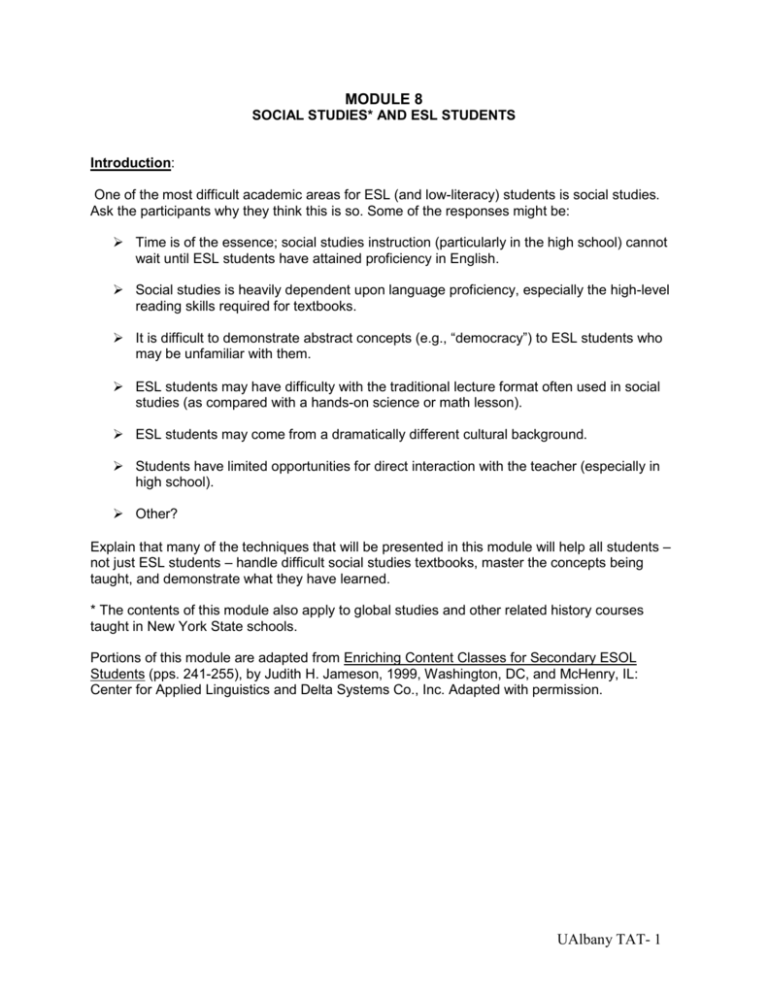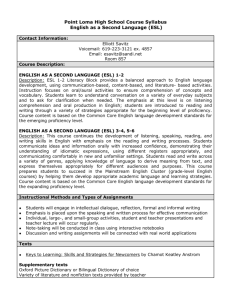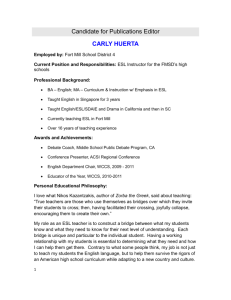Module 8 Social Studies and ESL Students
advertisement

MODULE 8 SOCIAL STUDIES* AND ESL STUDENTS Introduction: One of the most difficult academic areas for ESL (and low-literacy) students is social studies. Ask the participants why they think this is so. Some of the responses might be: Time is of the essence; social studies instruction (particularly in the high school) cannot wait until ESL students have attained proficiency in English. Social studies is heavily dependent upon language proficiency, especially the high-level reading skills required for textbooks. It is difficult to demonstrate abstract concepts (e.g., “democracy”) to ESL students who may be unfamiliar with them. ESL students may have difficulty with the traditional lecture format often used in social studies (as compared with a hands-on science or math lesson). ESL students may come from a dramatically different cultural background. Students have limited opportunities for direct interaction with the teacher (especially in high school). Other? Explain that many of the techniques that will be presented in this module will help all students – not just ESL students – handle difficult social studies textbooks, master the concepts being taught, and demonstrate what they have learned. * The contents of this module also apply to global studies and other related history courses taught in New York State schools. Portions of this module are adapted from Enriching Content Classes for Secondary ESOL Students (pps. 241-255), by Judith H. Jameson, 1999, Washington, DC, and McHenry, IL: Center for Applied Linguistics and Delta Systems Co., Inc. Adapted with permission. UAlbany TAT- 1 Notes: Where should social studies teachers begin when teaching ESL students with little or no proficiency in English? Display OH 8.1: Where to start…, and discuss. Ask the class if they can think of other things teachers can do. UAlbany TAT- 2 OH 8.1 Where to start with beginning-level limited English proficient (ESL) students 1. Wherever possible, provide native language support (through print or taped material in the student’s native language and/or volunteer tutors and translators). 2. Enlist other students to act as a “buddy,” to help the ESL student with classwork, note-taking and homework. 3. Use facial expressions, gestures and actions whenever possible, to get a point across to the ESL student. 4. Use pictures, videos and other visuals. 5. Get copies of the bilingual glossaries available in all areas of social studies and history, from the New York State Education Department. These can be used for teaching and testing purposes, by teachers as well as students, including student use while taking the New York State assessments. 6. Provide the student with a bilingual dictionary. 7. Provide printed notes for your lesson ahead of time so that the ESL student can concentrate on listening. 8. Adapt chapters of the social studies textbook to make it more comprehensible to the ESL student. 9. Adapt your questioning techniques. For example: “point to/show me,” “yes/no,” “either/or.” As ESL students progress, begin to use “what/where/when,” followed by “how” questions and then, still more advanced, “why” questions. UAlbany TAT- 3 Notes: How can social studies teachers adapt instructional materials to make them comprehensible to ESL students? Display OH 8.2: Helping ESL students understand …, and discuss. UAlbany TAT- 4 OH 8.2 Helping ESL Students Understand Social Studies Textbooks Make a photocopy of each textbook chapter. Cut and paste only those sections that the ESL student can understand. For example: the title, section headings, pictures and maps with captions underneath, and brief sections of text. (Some teachers adapt and assemble the entire textbook, save each modified chapter in a plastic sheet protector, and use it with new groups of ESL students every year.) Apply important pre-reading activities: asking pre-reading questions to direct the reading, having students brainstorm and predict what the text is about, activate students’ background knowledge, teach vocabulary clusters, etc. Teach signal words: Time – before, after, soon, finally, first… Additive – in addition to, moreover, also… Cause/Effect – as a result, since, because… Conclusive – consequently, in summary, therefore… Changing – nonetheless, despite, however… Teach types of text structure: Compare/Contrast Cause/Effect Problem/Solution Description Enumeration Sequential/Chronological Cooperative Learning groups: Divide the text up into sections and have each member of each cooperative learning group become an “expert” on one small section of the text and teach it to the other students. Use graphic organizers (see the following examples) UAlbany TAT- 5 Notes: The following overheads demonstrate various ways that social studies teachers can use graphic organizers to make both textbooks and classroom Instruction more comprehensible to the ESL student. This sequence, which demonstrates a process know as “From text to graphics and back again,” is taken from the Center for Applied Linguistics training manual (see introduction to this TAT Pack). Display OH 8.3: Knowledge Structures of… and explain that the first task of the teacher is to identify the major concepts of the chapter. In this case, four types of early man are being identified. Notes: Display OH 8.4: Early People and explain that this is an example of a timeline. Ask participants to put the relationships shown into a simple sentence. Identify language that might be difficult for the ESL student, such as “years ago.” Notes: Display OH 8.5: Graphic Presentation of Homo Habilis… and explain that this is a web technique that highlights important points from the chapter being read. Ask participants to generate language using this web, and explain that the teacher would then give the students a blank web to fill out while reading the chapter. Notes: Display OH 8.6: Chapter Review…and explain that the teacher would use this at the end of the chapter to help the students generate comparisons and contrasts and review the contents of the chapter. At this point, students have read text, filled in webs, talked about the content, and completed a summary matrix. All of this has reinforced both the language and the content of the chapter. Notes: Display OH 8.7: Student- Generated… Remind participants that: Teachers should use a few well-chosen graphic organizers repeatedly The organizer selected must accurately reflect the relationship it is depicting, e.g., a timeline. The organizer must contain key vocabulary that the students will need to use. Teachers should help students to become more and more independent in their use of graphic organizers (alone or in groups). UAlbany TAT- 6 Notes: Display OH 8.8: A Cause-Effect Table.. as another example of a graphic organizer. Have participants generate statements based on it. Notes: Display OH 8.9: Student-generated text. This last example shows how the student has now written text based on the graphics, thus completing the “text to graphics and back again” process. Notes: Display OH 8.10: map of the northeast and explain that this demonstrates how students with little or no English language ability can demonstrate what they have learned. UAlbany TAT- 7





